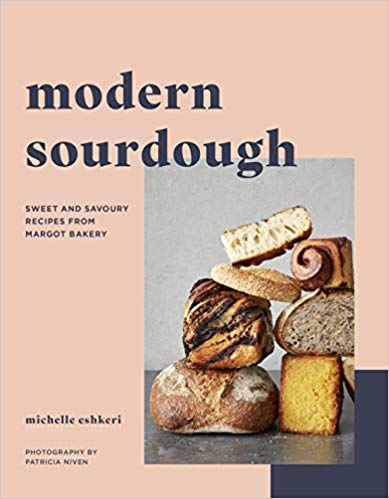
Modern Sourdough*
Expanding the Possibilities of Sourdough Baking
I grew up in the San Francisco Bay Area, so I know and love sourdough. I was delighted to see this particular cookbook at one of my book review sites, and I knew I had to check it out. The author owns a bakeshop in north London called the Margot Bakery. This book is simply divided into an introductory section which gives you basic skills and techniques required for sourdough baking, and this is followed by the recipe section which starts off with breads before going into other sweet and savory sourdough options (including pastries!). The book ends with a collection of specialties from the bakery that don’t include sourdough starter.
As someone who has worked with a sourdough starter, I found her introductory section helpful. If someone was interested in working with sourdough starters and the resulting goods made from them, this would be a good primer for sourdough baking. In very detailed steps, she tells how to make a starter. Other information includes how to care for and bake with starters and the dough process. After this introductory section, she dives right into the recipes. Most of the recipes in the bread section are the standard and typical breads from various countries around the world as well as favorites of different ethnicities. Probably most cultures that enjoy leavened bread are represented here. Of course, there are a lot of French and Italian breads, like brioche and ciabatta; however, there are a few surprises as well, like Lepeshka (Jewish) and Jachnun (from Yemen).
Things start to get interesting when the book moves on to pastries. In all my time working with sourdough starters, I had never considered making pastries. There’s even a laminated dough recipe that you use to make croissants, pain au chocolat, and several other pastries. There are definitely recipes that will get you thinking about sourdough baking in a completely different way. I love that. There’s a sweet sourdough section separate from the pastries; some interesting cultural staples like babka, panettone, and stollen. The savory sourdough section had more unusual delights, like Pugliese Potato Focaccia and Onion Focaccia Tarte Tatin. Some recipes from the basic bread chapter are repurposed in these later chapters. For instance, the brioche dough is used to make a recipe called Brioche Feuilletée and the focaccia dough is used to make Sourdough Pizzas. The author even gives some ideas to do with day-old breads, like stuffed twice-baked croissants and a bread pudding.
The recipes use only sourdough starter for the leavening. Given my experience working with sourdough, I know that this can be a dicey proposition. If I were making these breads and my starter didn’t look lively after the refreshment stages, I would probably add a little commercial yeast to hedge my bets. Except during the warmer months when my starter would sometimes overflow its container, I always added a teaspoon of regular yeast to my doughs.
After so many sourdough wonders, I was surprised at the Margot Specialties section, but I am glad the author included it. Salted caramel chocolate chip cookies, what’s not to like? And there are also other cookies and yummy sounding (and looking) recipes like Custard Tart with Caramelised Breadcrumbs and Blood Orange Polenta Cake. Fun stuff!
When I initially flipped through the book for my BookTube review, I had noticed there were both Imperial and metric measurements. However, I hadn’t realized that, for the breads at least (not toppings and extras), these are actually done as weights not as dry measures. I will admit I don’t even own a kitchen scale. I am a dump cook most of the time and cup-and-spoon measurer when baking. So, be warned, if you are interested in this book, you will need a kitchen scale and be willing to work with the weights of ingredients. The recipes look so good that I may be upgrading my kitchen tools.
Another thing that I noticed is that all of the sourdough recipes require either two or three refreshment stages before the bread (or good) can actually be made. The first refreshment stage is done with the entire starter that you have. Then 8-12 hours after that, there are one or two other stages. It seems that most of the sweeter breads had two refreshment stages, the second stage being one in which sugar was added to the starter. So making any recipe from this book would be a time commitment. It takes mere seconds to do a refreshment of a starter, but timing it around busy lives and schedules is what makes it tricky. And, of course, there is something about our modern human nature that wants results NOW!
The book is well photographed. If you love bread, you’ll be wishing you could jump on a plane to London and try some made by the hands of the author who created the recipes. Every recipe has a photo and truly gives a sense of what these breads and other baked goods look like. The author also included some detailed photos of more complex techniques, like braiding challah.
If you are already an experienced sourdough baker, you will be thrilled with the possibilities that this book opens up for you. If you are new to sourdough baking, this book provides good foundations and explanations as well as recipes that you can use in the early stages of learning as well as ones that will challenge you later.





